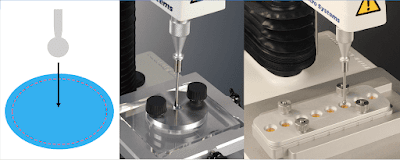Puncture
In some cases, variations on tensile testing can be simpler than the traditional, two grips method, while still providing the results needed by the manufacturer or researcher.
The Film Support Rig allows the measurement of the mechanical properties of fine films. Prior to performing the test, the sample is placed over a hole in a raised Perspex platform. A top plate prevents the sample from slipping during testing. The test is then carried out as the arm of the Texture Analyser brings a 5mm stainless steel ball probe down into the aperture. The sample is placed into a state of biaxial tension. The maximum force to rupture the film is recorded and is referred to as the burst strength of the sample.
 |
| Schematic diagram of a typical film puncture test on the Film Support Rig; Film Support Rig; Indexable Film Support Rig |
The resilience and relaxation properties of the film can also be measured. Resilience can be assessed by depressing the film surface to a chosen distance before retracting the ball probe, and calculated as the ratio between work of compression and work of withdrawal. Similarly, relaxation can be measured with the addition of a hold period within the test to allow the product’s recovery to be evaluated. Burst strength, resilience and relaxation are important factors in determining the mechanical properties of any polymer, allowing manufacturers to optimise product structure and formulation.
A similar rig exists for the measurement of multiple film burst tests – the Indexable Film Support Rig.
 |
| Typical compression testing using a cylinder probe |
Compression
Example standard methods: ASTM D695, ISO 604.
Compression testing is useful for the evaluation of a material’s behaviour under a uniaxial compressive load. This may be used to calculate fundamental material properties providing a sample of appropriate geometry is used (e.g. a solid circular or rectangular section prism, or a section of pipe). This type of test is particularly useful for the measurement of materials that are naturally used in compression, such as those used in the building industry (polymer concretes or foams). This type of test is also extremely useful for the assessment of non-fundamental properties, when a simple measurement of crushing force is helpful.
Compressive testing is generally used for stiffer, self-supporting samples, such as thermoplastic polymers destined for injection moulding, or thermosetting polymers.
 |
| Schematic diagram of typical compression tests: solid sample and pipe section |
INDENTATION AND PENETRATION
Indentation
Example standard method: ISO 7619-1.
 | |
|
 |
| Schematic diagram of typical indentation tests: Vickers and conical indenters |
The loading arm moves down at a constant speed, pushing the probe into the sample until it reaches a set force or distance. This force (or distance) is held for a given time period and the probe withdraws from the sample surface at a second constant speed. A residual imprint of the indenter is left behind in the sample, which corresponds to the degree of plastic deformation that took place. The majority of elastic deformation is released as the probe withdraws from the sample.
Polymers are generally indented using a ball indenter (Brinell hardness) or a Shore durometer, both of which can be supplied by Stable Micro Systems for measurement using a Texture Analyser. Diamond-shaped Vickers indenters may also be used by some polymer researchers, also supplied by Stable Micro Systems.
Shore durometers are used to determine indentation hardness of materials by using a measurement of resistance to deformation. A and D are the two most commonly used scales.
Shore hardness cannot be equated to other indentation hardness measurements. It is generally used as an empirical test for quality control as well as research and development rather than the investigation of a material’s properties. It is attractive for these purposes as it is a quick test to perform, and the hardness scale is easy to understand.
The majority of Shore hardness testing is carried out on standard and vulcanised rubber, thermoplastic elastomers, gels and plastics. Before measuring any of these materials, it is necessary to refer to Shore reference tables, as some materials are better suited to Shore methods other than A and D. The probes for Shore A and D have slightly different geometries (as illustrated).
Non-Standard Penetration: Viscous Polymer Measurement
The properties of viscous semi-solid polymers have faced increasing attention in recent years due to the much increased popularity of ‘play slime’ designed for children. The hardness and stickiness of these products are of particular importance, and can be measured using the Mini Stickiness System. This is based on the principle of subjecting a viscous polymer sample (or other viscoelastic semisolid) to shear while minimising the exposure of the cut surface to the atmosphere. A retaining plate is placed over the sample with limited compression of the piece being incurred because the height of the lid is predetermined by the size and shape of the sample.
A narrow blade is driven through a slot in the retaining plate to shear through the sample and after a given distance of travel is withdrawn. The intimate contact between sample and blade limits the potential for changes in sample rheology through exposure to the atmosphere.
There is a Texture Analysis test for virtually any physical property. Contact Stable Micro Systems today to learn more about our full range of solutions.
For more information on how to measure texture, please visit the Texture Analysis Properties section on our website.
No-one understands texture analysis like we do!
Get in touch to discuss your specific test requirements





No comments:
Post a Comment